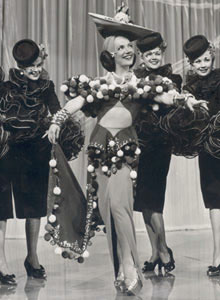Fruit hat
Fruit hat is a type of headwear that is designed to resemble a pile or arrangement of various fruits. This type of hat has been a part of popular culture and fashion in various parts of the world, often associated with tropical and festive themes. The fruit hat is most famously linked with the Brazilian samba dancer, singer, and film star Carmen Miranda, who popularized the style in the 1930s and 1940s.
History[edit | edit source]
The origins of the fruit hat can be traced back to the traditional costumes and headgear of tropical countries, where fruits are abundant and play a significant role in the culture. However, the fruit hat gained international fame through Carmen Miranda, who wore it as part of her performance costume. This led to the fruit hat becoming a symbol of the exuberant Latin American culture, as well as a popular fashion accessory in the United States and Europe during the mid-20th century.
Design[edit | edit source]
A typical fruit hat consists of a base hat that is then adorned with a variety of artificial fruits. Common fruits used in the design include bananas, pineapples, grapes, and apples, among others. The arrangement and type of fruits can vary greatly, making each fruit hat unique. The hats are often colorful and vibrant, reflecting the lively nature of the cultures they represent.
Cultural Significance[edit | edit source]
The fruit hat is more than just a fashion statement; it holds cultural significance in various parts of the world. In Brazil, the fruit hat is a reminder of the country's rich tropical environment and is often worn during carnivals and samba performances. It symbolizes joy, festivity, and the vibrant culture of the Brazilian people.
In Popular Culture[edit | edit source]
Beyond its cultural roots, the fruit hat has made numerous appearances in films, television shows, and stage performances, often as a symbol of tropical paradise or to evoke a sense of fun and festivity. Carmen Miranda's iconic look has been imitated and parodied countless times, cementing the fruit hat's place in popular culture.
Contemporary Use[edit | edit source]
Today, the fruit hat can be seen in costume parties, theatrical productions, and during carnival celebrations around the world. It remains a popular choice for those looking to add a touch of whimsy and color to their attire. The fruit hat also serves as an inspiration for fashion designers looking to incorporate tropical elements into their designs.
See Also[edit | edit source]
Search WikiMD
Ad.Tired of being Overweight? Try W8MD's physician weight loss program.
Semaglutide (Ozempic / Wegovy and Tirzepatide (Mounjaro / Zepbound) available.
Advertise on WikiMD
|
WikiMD's Wellness Encyclopedia |
| Let Food Be Thy Medicine Medicine Thy Food - Hippocrates |
Translate this page: - East Asian
中文,
日本,
한국어,
South Asian
हिन्दी,
தமிழ்,
తెలుగు,
Urdu,
ಕನ್ನಡ,
Southeast Asian
Indonesian,
Vietnamese,
Thai,
မြန်မာဘာသာ,
বাংলা
European
español,
Deutsch,
français,
Greek,
português do Brasil,
polski,
română,
русский,
Nederlands,
norsk,
svenska,
suomi,
Italian
Middle Eastern & African
عربى,
Turkish,
Persian,
Hebrew,
Afrikaans,
isiZulu,
Kiswahili,
Other
Bulgarian,
Hungarian,
Czech,
Swedish,
മലയാളം,
मराठी,
ਪੰਜਾਬੀ,
ગુજરાતી,
Portuguese,
Ukrainian
Medical Disclaimer: WikiMD is not a substitute for professional medical advice. The information on WikiMD is provided as an information resource only, may be incorrect, outdated or misleading, and is not to be used or relied on for any diagnostic or treatment purposes. Please consult your health care provider before making any healthcare decisions or for guidance about a specific medical condition. WikiMD expressly disclaims responsibility, and shall have no liability, for any damages, loss, injury, or liability whatsoever suffered as a result of your reliance on the information contained in this site. By visiting this site you agree to the foregoing terms and conditions, which may from time to time be changed or supplemented by WikiMD. If you do not agree to the foregoing terms and conditions, you should not enter or use this site. See full disclaimer.
Credits:Most images are courtesy of Wikimedia commons, and templates, categories Wikipedia, licensed under CC BY SA or similar.
Contributors: Prab R. Tumpati, MD


